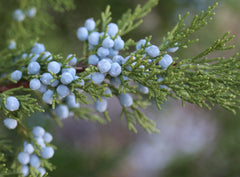
Junipers – Junipers – Junipers everywhere! Have you ever wondered about juniper’s significance and purpose, aside from giving you allergies? To my surprise, I found very little written information about this hardy tree/shrub. I was determined to dig deeper for factual references and folkloric uses of the juniper tree. Here is what I found:
Habitat
In his book, Medicinal Plants of the Desert and Canyon West, Michael Moore explains that there are two general types of junipers. Small trees with dark olive green scaly, leafless twigs and the high altitude spreading shrub with sharp, pine like needles. The seeds or fruit of the tree are strongly aromatic, almost perfectly round, green initially, and turning frosted blue by spring. Juniper trees are widely distributed throughout the northern hemisphere. There are about 50 – 67 species of juniper.
Commercial Uses
Commercially, juniper berries are used for making gin. The name gin takes its name from “genevrier”, the French name for juniper. Juniper berries are also used as the primary flavor in the liquor Jenever and sahti-style of beers. Juniper berries can also be found in sauerkraut, German potato salad, as well as in marinades and in cooking any wild tasting meats. In the perfume industry it is prized as a “masculine” scent much used in men’s cologne and aftershave.
Medicinal Uses And Preparation
Juniper is mainly a urinary tract herb, used for urinary infections and as a diuretic. It is also being used for coughs, colds, fever, ulcers, wounds, boils, and for easing muscular or joint pain in chronic conditions such as gout, arthritis and rheumatism. Dr. James Duke, the late and former United States Department of Agriculture researcher, says that he likes to drink juniper tea when he feels a cold coming on. One teaspoon of berries or leaves steeped in a cup of hot water may be sipped several times a day. Because of juniper’s antiseptic properties, a tea can also be used as a wash to disinfect the skin. For sore muscles, massage a small amount (about one ounce) of vegetable oil to which you have added 3 drops of juniper essential oil. If you have sensitive skin, you may try to make your own infused oil:
Recent studies suggest that juniper berries may be useful in treating insulin-dependant diabetes. Matthew King, aka, Noble Red Man of the Lakota nation, tells his story about his bout with diabetes. “Once, while I was up on the mountain, I prayed to God to give us a cure for diabetes. And while I was there, somebody said, “Turn around!” So I turned around and there was the most beautiful Indian woman I’d ever seen. She was holding something out to me in her hand. It was those little berries of the *cedar (juniper) tree. Later on, when I got diabetes, I forgot about the berries. They sent me to White Man’s doctors. They gave me pills. Every morning I had to take insulin. I spent a lot of time in the hospital. Then I remembered White Buffalo Calf Woman and those little blue *cedar (juniper) berries. I picked some, boiled them, strained the juice, and drank it. It’s so bitter it took the sugar right out of my body. The doctors checked me and were amazed. They said the diabetes was gone. I did not have to take insulin anymore”. (Excerpt from the book “Wisdomkeepers” by Steve Wall and Harvey Arden).
Native-American Uses Of Juniper
The juniper tree, aka. “Medicine Tree” provided Native American people with food and medicine, fuel, wood for shelter or utensils, jewelry, and for ceremonial purposes. To this day, blue corn mush with juniper ash, is a favorite dish among many Native American tribes. Also, juniper ash is being used instead of baking soda in many dishes. Juniper ash can be made into juniper water for medicinal purposes. Arviso, while director of the Navajo tribe’s Navajo Food and Nutrition department, led a scientific study on the nutritional values of traditional Navajo foods. He discovered that the ash made from burning juniper, cooked in blue corn meal mush, is an amazing source of calcium and many other minerals.
Blue Corn Mush With Juniper Ash
- 1 cup juniper ash* prepared with 1 cup water
- 3 cups boiling water
- 4 cups blue cornmeal
Mix juniper ash with 1 cup water. Strain ashes into 3 cups of boiling water. Add cornmeal and stir until thickened.
*Juniper ash is made by firstly gathering small pieces of juniper bark. Place them into a cast iron skillet. Set them on fire and let them burn to an ash. Now you have juniper ash.
Caution: Juniper’s volatile oils can irritate the urinary tract and may have a vasodilating effect on the uterine lining. Therefore, juniper tea and berries should be avoided by people with kidney disease and during pregnancy.
*Some juniper trees are given the common name “cedar”. Scientific names have little meaning to the Native American people using them as medicine in traditional ways.
Written by Leilah

